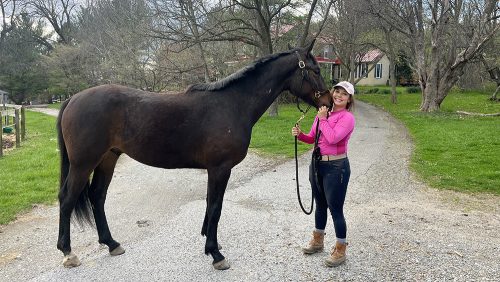In August, I observed a very important anniversary: the first anniversary of my return to riding. You may remember reading my column about my laughable first attempt at being back in the saddle following a two-year break.
In the past 12 months I have managed to rebuild my strength, rebuild my stamina, and rebuild my lower body into a shape that fits into my riding pants again.
Prior to my hiatus I’d always ridden and owned Thoroughbreds, all of which were light, lithe, sensitive partners that rode like performance sports cars with power steering and on-the-spot acceleration. Post-hiatus, I found myself riding completely different types of horses that required a brand new set of skills.
This summer my “mane” squeeze was a wonderful white Hammoverian (no, that’s not a misspelling, and if you saw him you’d understand) gelding, who quickly became my favorite. Fabulously stout and round, (saddling him is sort of like trying to girth up the Hindenburg) and with a noble bearing, he looks like the white horse that would carry the Knight in fairytales.
If the Knight didn’t really want to go anywhere, that is.
Aptly nicknamed “Turtle,” he is the epitome of the energy-conserving mammal; the polar-bear opposite of my Thoroughbreds, perfectly suited to be a balloon in the Macy’s Thanksgiving Day Parade, if only he didn’t weigh 1,600 pounds.
He is a beautiful horse with lovely movement, although he does not consider moving mandatory. He is painstakingly slow. Continents drift faster. A glacier could outrun him. Pluto could make it around the sun before you can walk him from the barn to the arena.
He doesn’t see the point of going forward unless the ground is, say, on fire, or until he spies a particularly tasty looking patch of greenery. Woe betide the person who walks him too close to the mulberry tree. You’ll need a winch to pull his head out of the foliage.
Most of the time, Turtle didn’t pay particular attention to where he was going, either. If I didn’t guide him at the walk he’d run into things, stumble around like a drunken sailor, and end up in a ditch.
ADVERTISEMENT
Unlike my little Thoroughbred, who turned on a dime with the slightest application of aids, Turtle is more like steering the Queen Mary: he requires a large berth for maneuvering, as well as advance planning. My first attempt at a tight turn-back played out like the scene in Titanic, where the lookouts in the crow’s nest are staring at the approaching iceberg and shouting, “WHY AREN’T WE TURNING?”
Apparently, any messages to change course or speed must be relayed via some long chain of command in the Turtle’s body and only then might the engines respond properly to execute the request.
Despite a considerable learning curve, I finally figured out how to get him forward, balanced and engaged. When I did, it felt like bouncing along on a cloud.
I got to test these newfound skills when I was given the opportunity to ride Turtle in an under saddle class at a horse show. For those of you unfamiliar with the ways of hunter/jumper horse shows, the under saddle classes are held in the same arena as the jumping classes. This means there are eight to 10 fences you must circumnavigate while also taking care not to run into any of the other horses. There may be three horses in the class, or 23. You never know.
I have actually knocked down a fence during an under saddle class (for those of you who are already thinking, “Oh, ha, ha, that doesn’t happen”—ha, ha, yes it did). I was riding an unfamiliar horse for a friend who had two horses entered in the adult amateur under saddle class. I didn’t know the horse had a wicked left drift until he wicked-left-drifted off the rail and caught a jump wing with his haunch.
It pushed the standard off its axis enough that all the poles fell off. I’m grateful the fences were far enough apart that I didn’t start some kind of domino effect and take out the whole course.
Sometimes the jump crew will pull the poles off the jumps on the outside lines so that riders can go between the standards and use more of the arena. Without the weight of the rails and panels to anchor them, the standards are even easier to knock over.
If you’re lucky, the standard will wobble for a little bit before it falls. By that time you’ll be far enough away that there will be reasonable doubt as to who caused it. If it’s really your day it’ll spook a few six-figure horses right out of their canters and move you up in the ribbons.
My own under saddle class was at an AA-rated show—the biggest show of the year—and consisted of 18 of the nicest horses I’d ever seen. They looked like enchanted forest creatures that could not possibly exist in real life. They didn’t trot; they floated. Their canters were the stuff dreams were made of.
ADVERTISEMENT
It was like a herd of genetically engineered hack winners. I tried not to let my confidence erode as I imagined their lissome bodies floating past us while we looked like an International Harvester plowing up the ground in comparison.
But I knew Turtle had beautiful gaits, and my worrying was for naught. The moment he stepped into the arena, he perked up and went into “show mode.” Ears forward and neck arched, he offered his loveliest trot and best canter, responded to every aid, and for seven glorious minutes made me feel as though I was mounted on Pegasus. I couldn’t have asked him to be a finer fellow.
As we lined up at the conclusion of the class, I did not envy the judge. There were many, many more horses than ribbons to give. How he was going to put these magnificent creatures in any sort of order was a mystery to me. Turtle stood proudly, a shining white beacon in a sea of chestnut and bay. He got whoops and hollers from our friends on the rail when he was called for the purple ribbon.
Once outside the arena, as people congratulated us, he went back in to Turtle-mode and fell half asleep while I was still sitting on him. On the slow walk back to the barn he tried to eat every bush and tree he passed, knocked over a garbage can, and tripped over what can only be described as a twig. When I put him in the crossties he promptly made manure and stepped in it.
When I put him in his stall, he turned and looked at me over his shoulder. I knew the moment I was out of sight he was going to roll and get filthy.
But that was OK. He earned it.
After years of trying to fit in with corporate America, Jody Lynne Werner decided to pursue her true passion as a career rather than a hobby. So now, she’s an artist, graphic designer, illustrator, cartoonist, web designer, writer and humorist. You can find her work on her Misfit Designs Cafepress site. Jody is one of the winners of the Chronicle’s first writing competition. Her work also appears in the annual Amateur Issue print editions of The Chronicle of the Horse.















